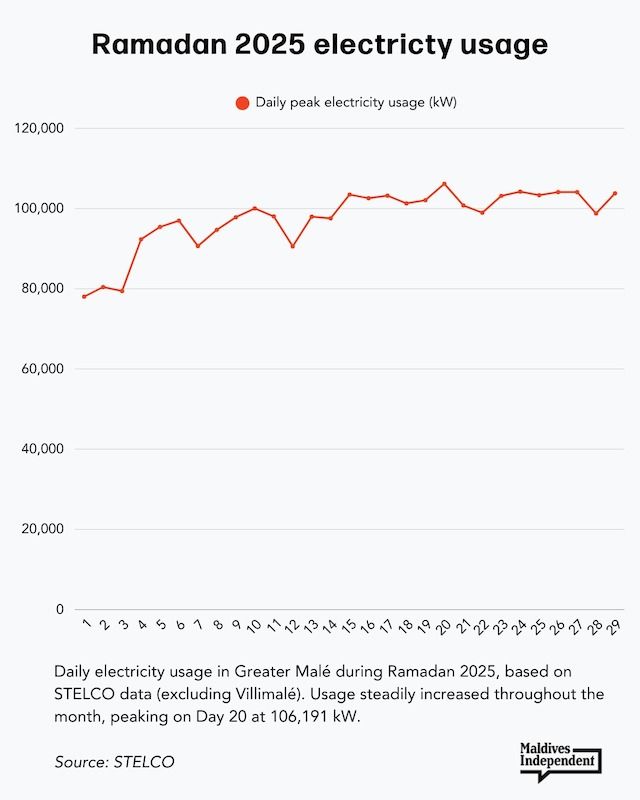Double burn: Maldives battles heat wave and surprise electricity bills despite Ramadan discount
Electricity charges surged despite a Ramadan discount.

Artwork: Dosain
07 Apr, 5:46 PM
After one of the hottest months on record, Maldivians felt the heat again when electricity bills arrived for March.
Despite promised government relief for Ramadan, charges were considerably higher than previous months, leaving many with more questions than savings as complaints piled up on social media.
“What are they doing? Charging us for the Eid lights and the masdhalhu [tuna can] handouts?” a person asked on TikTok, echoing widespread outrage.
Others questioned the application of the 10 percent discount pledged by President Dr Mohamed Muizzu for the holy month, a subsidy introduced during the first year of his administration.
“What's the discount rate? From my bill, it's only MVR 109 (US$ 7). But I know people who have bigger discounts like even MVR 1,000,” a resident living in Villimalé said.
But the billing spikes reflected a predictable pattern of higher electricity consumption during March and April, the warmest period of the year, utility company countered. The use of airconditioning equipment increased due to higher temperatures and busier kitchens, driving up electricity usage beyond normal levels, according to the State Electricity Company, which provides services in the Greater Malé Region.
Heat stress
The correlation between outside temperatures and electricity usage was clear from STELCO’s data.
The usage was lowest at the start of March, which coincided with the beginning of Ramadan, peaking at 80 megawatts, down from the average peak of 100 megawatts in Malé. The Maldives experienced heavy rainfall during the first three days of March as the Met office issued multiple alerts for torrential downpour and thunderstorms across the country.
The capital and the central atolls were the worst affected. A staggering 296mm of rainfall in Kaafu Dhiffushi was the highest daily accumulated rainfall recorded since the Met office started collecting data.
But when the rains cleared, temperatures soared and electricity usage rose in tandem, hitting 100 megawatts by March 10. Over the next week, the full force of the dry Iruvai monsoon kicked in throughout the country with “feels-like” temperatures rising above 40 degrees Celsius.
On March 16, the Met office cautioned the public about the risk of heat stress.
“High humidity, weaker winds, clear skies, and direct overhead high solar radiation during mid-March and throughout April, along with the high air temperature causes moist warm air to stagnate,” the heat advisory explained.
“This results in a high heat index, causing people to feel temperature higher than the actual air temperature as the body cannot sweat enough to cool down – this is calculated as feels like temperature.”
Electricity usage surged during this period. Between March 15 and March 29, daily usage peaked around 100 to 104 megawatts daily, except for two days when the peak dropped to 98 megawatts.

According to the Met office, the annual average number of days with a heat index exceeding 35 degrees Celsius is projected to increase significantly under climate change modelling based on all the scenarios outlined by the IPCC.
The Maldives historically recorded only a handful of days each year with the heat index exceeding 35 degrees Celsius. But by 2050, this could rise as high as 78 days, according to conservative estimates based on the projections.
Discounts and efficiency
To provide the promised discount, STELCO calculated an average usage for every household, a spokesman explained. February, March and April, the hottest months of the year, were excluded as electricity consumption would have been above average. The average usage was based on the other nine months.
“The president’s pledge was that electricity bills will not be higher than a normal month for a household. So that [is what it is based on]. So if bills are higher than that average, the discount covers whatever amount exceeded the average,” a senior STELCO management official told the Maldives Independent.
As a result, the Ramadan discount was not a flat rate across households.
For households with newly installed meters and no usage history, STELCO applied a 10 percent flat rate, the official said.
A media official for Fenaka, the state-owned utility that provides electricity on most other islands, was unavailable for comment.
Over the past few years, the market has been flooded with air conditioning and cooling equipment that are not energy efficient, the owner of a repair service in Malé, told the Maldives Independent.
“Some of it is actually poor quality as well and needs to be repaired or some part replaced in less than a year. Actually, you can’t even replace parts in most cases because it isn’t designed for that,” he explained.
“It is cheaper. But only the one-time cost of buying. How long does it last? Is it a quality product? How much energy does it use? This adds to the original cost. In the end it is more expensive.”
In 2021, the environment ministry launched an energy efficiency rating programme called Hakathari, a fusion of the Dhivehi words for energy and star. The programme set minimum energy performance standards and assigned ratings between one to five stars, with five denoting excellent.
The programme is currently open to importers to apply to rate their air conditioning, refrigeration and washing machine products. Some 81 different products have been rated to date.
Users need to consider energy efficiency and usage for household electronics, especially with cooling equipment, an environment ministry official advised.
“It is increasingly becoming warmer and we have high ‘feels-like’ temperatures every year. So we have to rely on ACs continuously," she said. "So the best option is to get energy efficient products. You can check the Hakathari page on our website, where you can find different brands and models and can compare energy efficiency."
Discussion
No comments yet. Be the first to share your thoughts!
No comments yet. Be the first to join the conversation!
Join the Conversation
Sign in to share your thoughts under an alias and take part in the discussion. Independent journalism thrives on open, respectful debate — your voice matters.




